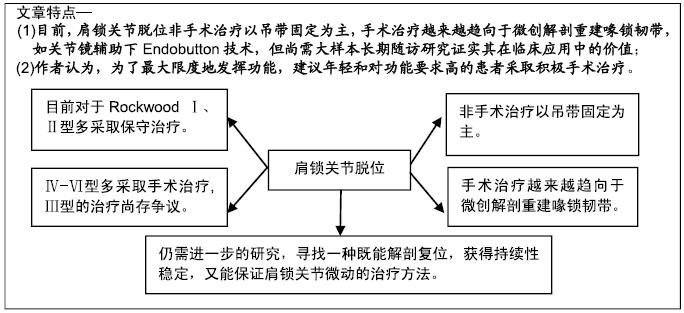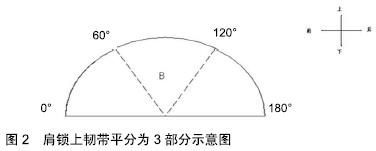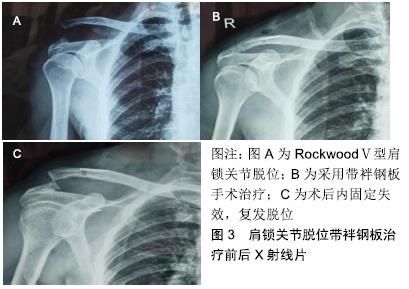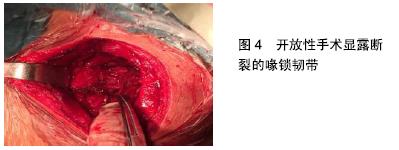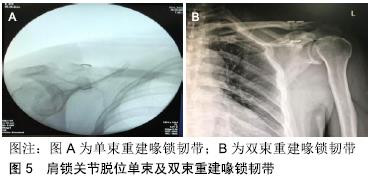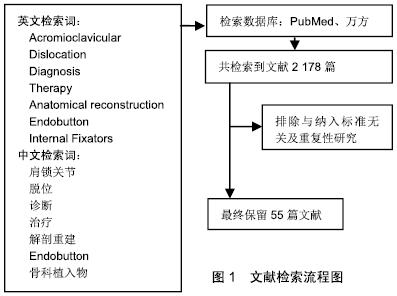[1] PALLIS M, CAMERON KL, SVOBODA SJ,et al.Epidemiology of acromioclavicular joint injury in young athletes.Am J Sports Med. 2012; 40(9):2072-2077.
[2] MARKEL J, SCHWARTING T, MALCHERCZYK D, et al. Concomitant glenohumeral pathologies in high-grade acromioclavicular separation (type III - V).BMC Musculoskelet Disord. 2017;18(1):439.
[3] BEITZEL K, COTE MP, APOSTOLAKOS J,et al.Current concepts in the treatment of acromioclavicular joint dislocations.Arthroscopy. 2013 Feb;29(2):387-397.
[4] BARTH J, BOUTSIADIS A, NARBONA P, et al.The anterior borders of the clavicle and the acromion are not always aligned in the intact acromioclavicular joint: a cadaveric study.J Shoulder Elbow Surg. 2017; 26(7):1121-1127.
[5] MAZZOCCA AD, ARCIERO RA, BICOS J.Evaluation and treatment of acromioclavicular joint injuries.Am J Sports Med.2007;35(2):316-329.
[6] MORIKAWA D, DYRNA F, COTE MP, et al.Repair of the entire superior acromioclavicular ligament complex best restores posterior translation and rotational stability.Knee Surg Sports Traumatol Arthrosc. 2018 Oct 10.
[7] RIOS CG, ARCIERO RA, MAZZOCCA AD.Anatomy of the clavicle and coracoid process for reconstruction of the coracoclavicular ligaments. Am J Sports Med. 2007;35(5):811-817.
[8] MAZZOCCA AD, SPANG JT, RODRIGUEZ RR, et al.Biomechanical and radiographic analysis of partial coracoclavicular ligament injuries.Am J Sports Med.Am J Sports Med. 2008;36(7):1397-1402.
[9] HEERS G, HEDTMANN A.Correlation of ultrasonographic findings to Tossy's and Rockwood's classification of acromioclavicular joint injuries. Ultrasound Med Biol. 2005;31(6):725-732.
[10] FARUCH BILFELD M, LAPÈGUE F, CHIAVASSA GANDOIS H, et al. Ultrasound of the coracoclavicular ligaments in the acute phase of an acromioclavicular disjonction: Comparison of radiographic, ultrasound and MRI findings.Eur Radiol. 2017;27(2):483-490.
[11] ALYAS F, CURTIS M, SPEED C,et al.MR Imaging appearances of acromioclavicular joint dislocation. Radiographics. 2008;28(2):463-479.
[12] VAN BERGEN CJA, VAN BEMMEL AF, ALTA TDW,et al.van Noort, New insights in the treatment of acromioclavicular separation.World J Orthop.2017;8(12):861-873.
[13] GRANVILLE-CHAPMAN J, TORRANCE E, RASHID A, et al.The Rockwood classification in acute acromioclavicular joint injury does not correlate with symptoms.J Orthop Surg (Hong Kong). 2018;26(2): 2309499018777886.
[14] ESCHLER A,RÖSLER K, ROTTER R, et al.Acromioclavicular joint dislocations: radiological correlation between Rockwood classification system and injury patterns in human cadaver species.Arch Orthop Trauma Surg. 2014;134(9):1193-1198.
[15] ALLEMANN F, HALVACHIZADEH S, WALDBURGER M, et al. Different treatment strategies for acromioclavicular dislocation injuries: a nationwide survey on open/minimally invasive and arthroscopic concepts. Eur J Med Res. 2019;24(1):18.
[16] MURRAY IR, ROBINSON PG, GOUDIE EB, et al.Robinson, Open Reduction and Tunneled Suspensory Device Fixation Compared with Nonoperative Treatment for Type-III and Type-IV Acromioclavicular Joint Dislocations: The ACORN Prospective, Randomized Controlled Trial.J Bone Joint Surg Am. 2018;100(22):1912-1918.
[17] 孙根文,帕拉提•阿巴伯艾力, 李涛,等. 植入物内固定与保守疗法修复Rockwood Ⅲ型肩锁关节脱位的系统评价[J].中国组织工程研究,2016, 20(13):1946-1953.
[18] TANG G, ZHANG Y, LIU Y, et al.Comparison of surgical and conservative treatment of Rockwood type-III acromioclavicular dislocation: A meta-analysis.Medicine (Baltimore). 2018;97(4):e9690.
[19] SCHLIEMANN B, ROßLENBROICH SB, SCHNEIDER KN, et al. Weimann, Why does minimally invasive coracoclavicular ligament reconstruction using a flip button repair technique fail? An analysis of risk factors and complications.Knee Surg Sports Traumatol Arthrosc. 2015;23(5):1419-1425.
[20] FLINT JH, WADE AM, GIULIANI J, et al. Defining the terms acute and chronic in orthopaedic sports injuries: a systematic review.Am J Sports Med.2014;42(1):235-241.
[21] WANG Y, ZHANG J.Acromioclavicular joint reconstruction by coracoid process transfer augmented with hook plate.Injury. 2014;45(6):949-954.
[22] 祝李霖,黄东,吴伟炽,等.锁骨钩钢板联合阔筋膜治疗陈旧性肩锁关节脱位[J].中华创伤骨科杂志,2016, 18(6):542-544.
[23] BUSS DD, ANDERSON K, TERVOLA N, et al.Giveans, Posterior Distal Clavicle Beveling for Chronic Nonincarcerated Type IV Acromioclavicular Separations: Surgical Technique and Early Clinical Outcomes, Arthroscopy. 2017;33(1):84-89.
[24] PONCE BA, MILLETT PJ, WARNER JJ. Acromioclavicular joint instability-reconstruction indications and techniques, Operative Techniques in Sports Medicine.2004;12(1):35-42.
[25] THOMAS K, LITSKY A, JONES G,et al.Biomechanical comparison of coracoclavicular reconstructive techniques.Am J Sports Med. 2011; 39(4):804-810.
[26] LI G, LIU T, SHAO X, et al.Fifteen-degree clavicular hook plate achieves better clinical outcomes in the treatment of acromioclavicular joint dislocation.J Int Med Res.J Int Med Res. 2018;46(11):4547-4559.
[27] HUNG LK, SU KC, LU WH, et al. Biomechanical analysis of clavicle hook plate implantation with different hook angles in the acromioclavicular joint.Int Orthop. 2017;41(8):1663-1669.
[28] KIENAST B, THIETJE R, QUEITSCH C, et al. Mid-term results after operative treatment of rockwood grade III-V Acromioclavicular joint dislocations with an AC-hook-plate.Eur J Med Res. 2011;16(2):52-56.
[29] LIN HY, WONG PK, HO WP, et al.Clavicular hook plate may induce subacromial shoulder impingement and rotator cuff lesion - dynamic sonographic evaluation.J Orthop Surg Res. 2014;9:6.
[30] KIM E, LEE S, JEONG HJ, et al.Three-dimensional scapular dyskinesis in hook-plated acromioclavicular dislocation including hook motion.J Shoulder Elbow Surg. 2018;27(6):1117-1124.
[31] LEE YS, LAU MJ, TSENG YC, et al.Comparison of the efficacy of hook plate versus tension band wire in the treatment of unstable fractures of the distal clavicle.Int Orthop. 2009;33(5):1401-1405.
[32] LEE S, BEDI A.Shoulder acromioclavicular joint reconstruction options and outcomes, Curr Rev Musculoskelet Med.2016; 9(4):368-377.
[33] BEITZEL K, OBOPILWE E, CHOWANIEC DM, et al. Biomechanical properties of repairs for dislocated AC joints using suture button systems with integrated tendon augmentation, Knee Surg Sports Traumatol Arthrosc.2012;20(10):1931-1938.
[34] WELLMANN M, ZANTOP T, WEIMANN A, et al. Biomechanical evaluation of minimally invasive repairs for complete acromioclavicular joint dislocation.Am J Sports Med. 2007;35(6):955-961.
[35] 韩冰,冯晖,陈烁,等.修复Ⅲ度肩锁关节脱位:带线锚钉重建喙锁韧带的生物力学变化[J].中国组织工程研究,2015,19(4):568-572.
[36] GAROFALO R, CECCARELLI E, CASTAGNA A, et al.Open capsular and ligament reconstruction with semitendinosus hamstring autograft successfully controls superior and posterior translation for type V acromioclavicular joint dislocation.Knee Surg Sports Traumatol Arthrosc. 2017;25(7):1989-1994.
[37] WELLMANN M, KEMPKA JP, SCHANZ S, et al.Coracoclavicular ligament reconstruction: biomechanical comparison of tendon graft repairs to a synthetic double bundle augmentation.Knee Surg Sports Traumatol Arthrosc. 2009;17(5):521-528.
[38] 张黎明,汪志芳,施海伟.关节镜辅助锁扣带袢双钛板TightRope置入修复肩锁关节脱位:早期即可坚强固定[J].中国组织工程研究,2015,19(9): 1441-1446.
[39] FAHMY FS, FATHI H, ELATTAR M.Clinical outcomes of arthroscopic assissted fixation of acute high grade acromioclavicular joint disruption. J Orthop. 2019;16(2):133-136.
[40] MARSALLI M, MORAN N, LASO JI.Arthroscopic Acromioclavicular Joint Reconstruction With TightRope and FiberTape Loop.Arthrosc Tech. 2018;7(11):e1103-e1108.
[41] XU J, LIU H, LU W, et al.A retrospective comparative study of arthroscopic fixation in acute Rockwood type IV acromioclavicular joint dislocation: single versus double paired Endobutton technique.BMC Musculoskelet Disord. 2018;19(1):170.
[42] LU D, WANG T, CHEN H, et al.A comparison of double Endobutton and triple Endobutton techniques for acute acromioclavicular joint dislocation.Orthop Traumatol Surg Res. 2016;102(7):891-895.
[43] PARK I, ITAMI Y, HEDAYATI B, et al.Biomechanical Analysis of Single-, Double-, and Triple-Bundle Configurations for Coracoclavicular Ligament Reconstruction Using Cortical Fixation Buttons With Suture Tapes: A Cadaveric Study.Arthroscopy. 2018;34(11):2983-2991.
[44] SCHEIBEL M, DRÖSCHEL S, GERHARDT C, et al. Arthroscopically assisted stabilization of acute high-grade acromioclavicular joint separations.Am J Sports Med. 2011;39(7):1507-1516.
[45] JORDAN RW, MALIK S, BENTICK K, et al.Acromioclavicular joint augmentation at the time of coracoclavicular ligament reconstruction fails to improve functional outcomes despite significantly improved horizontal stability, Knee Surg Sports Traumatol Arthrosc. 2018 Sep 28
[46] SAIER T, VENJAKOB AJ, MINZLAFF P, et al.Value of additional acromioclavicular cerclage for horizontal stability in complete acromioclavicular separation: a biomechanical study.Knee Surg Sports Traumatol Arthrosc. 2015;23(5):1498-1505.
[47] KOCADAL O, YÜKSEL K, GÜVEN M.Evaluation of the clavicular tunnel placement on coracoclavicular ligament reconstruction for acromioclavicular dislocations: a finite element analysis.Int Orthop. 2018;42(8):1891-1896.
[48] EISENSTEIN ED, LANZI JT, WATERMAN BR, et al. Medialized Clavicular Bone Tunnel Position Predicts Failure After Anatomic Coracoclavicular Ligament Reconstruction in Young, Active Male Patients.Am J Sports Med. 2016;44(10):2682-2689.
[49] YU XB, LI T, HU W, et al.Position of Coracoid Button Predicts Loss of Reduction in Acromioclavicular Joint Dislocation Patients Treated With the Suture-Button.J Invest Surg. 2019:1-6.
[50] ZHU NF, RUI BY, ZHANG YL,et al.Anatomic study of coracoclavicular ligaments for reconstruction of acromioclavicular joint dislocations.J Orthop Sci. 2016;21(6):749-752.
[51] 薛骋,徐海波,宋李军,等.喙锁韧带完全解剖重建的钻孔技术研究[J].中华创伤骨科杂志, 2015,17(4):337-341.
[52] MARTETSCHLÄGER F, HORAN MP, WARTH RJ, et al. Complications after anatomic fixation and reconstruction of the coracoclavicular ligaments. Am J Sports Med. 2013;41(12):2896-903.
[53] DUNN JC, WATERMAN BR.Successful nonoperative management of coracoid fracture associated with suture-button fixation of acromioclavicular separation.Mil Med. 2015;180(1):e138-41.
[54] GONZALEZ R, DAMACEN H, NYLAND J,et al. Acromioclavicular joint reconstruction using peroneus brevis tendon allograft.Arthroscopy. 2007;23(7):788.e1-4.
[55] THEOPOLD J, MARQUASS B, VON DERCKS N, et al. Arthroscopically guided navigation for repair of acromioclavicular joint dislocations: a safe technique with reduced intraoperative radiation exposure. Patient Saf Surg. 2015;9:41.
|
